March 2008 – Catamaran Sailing – Crossing to Hawaii
Saturday March 1, 2008 – The night before
leaving for Hawaii
Hello everyone! It is now 6 p.m. and we are all
packed up and ready for our trip to Hawaii. We leave at 7 am tomorrow morning.
The last 6 weeks have just flew by as we prepared
the boat and ourselves for our first significant offshore passage, 2,700 mile
from Mexico to Hawaii. We did manage to squeeze in 2 one-week trips to the islands
25 miles north of La Paz.
Our route is as follows:
- We will leave La Paz on Sunday March 2 and
will do the 135 miles around the Baja peninsula to Cabo San Lucas in 3 day
trips of 45 miles where we will stop overnight at Los Muertos and Los Frailes.
- We will do a final weather check when off Cabo on Tuesday
March 4 and if the 7-day forecast still looks good we will depart the coast
off Cabo on Tuesday evening.
- Our route is not the great circle route (shortest) route
to Hawaii. Cabo is at 23 degrees north latitude and so we will sail off to
the southwest on a heading of 225 degrees depending on the wind and waves
to the latitude of 17 degrees north where the trade winds are steadier.
- We will sail by the small essentially uninhabited islands
of Socorro and Clarion (each about 10 miles in diameter with just one small
Mexican navy outpost of 20 people on Socorro) and then turn west staying on
the latitude of 17 degrees north until we are about 500 miles away for Hilo
on the big island of Hawaii. At that point we will turn northwest until we
check into Hilo which is at 20 degrees north latitude. Our total trip distance
is 2,700 nautical miles.
- The typical winds start as coming from the north to northwest
along the coast of the Baja and then become northeast trade winds when you
get about 500 to 700 miles off the coast of Mexico and as you approach Hawaii
they become east to northeast.
Typical winds speeds are 10 to 15 knots for the first half
of the trip and then 15 to 25 knots for the last half depending on the strength
of the trade winds. This year we are in what we are called a El Nina period
which means that the trades are stronger in the western Pacific so we may have
stronger trade winds to really push us along for the last half of the trip.
If we can average 5.6 knots of boat speed (which is reasonable for our boat)
it will take us 20 days. This is considered a fairly fast passage but if the
winds are lighter we could be out there 25 days. We are expecting to arrive
in Hilo by the end of March if everything works well. When we get to Hilo we
will call home to Vancouver and family back east that we have arrived safely.
I am sure that we will have some interesting stories of the adventure and experience.
To hopefully alleviate everyone’s concerns, about hundred sailboats
(many smaller than us) sail this route from Mexico to Marquesas/Tahiti in the
South Pacific or to Hawaii every year. It is considered an relatively easy and
safe passage in the recommended time of year of March to May as most boats leave
in March or April so they are off out of Mexico before hurricane season which
starts June 1.
While travelling for this 20 to 25 days we will be not be able
to communicate with anyone (unless a ship or freighter comes within the 20 mile
hailing range of our VHF radio) but we will be listening daily to the high seas
weather forecasts and ham radio nets on our short wave radio, as well as, downloading
weather faxes.
Expanded Summary of Trip from La Paz to
Hilo
Written the day after arriving on Saturday March 29, 2008
We are safely anchored in Radio Bay near the cruise
ship terminal in Hilo after an “interesting” 23-day passage. It
was definitely character building experience for both of us. We thought of all
of you often. First of all there is a lot of water on this planet. It is hard
to fully comprehend the immensity of the ocean. The water in the deep ocean
is a brilliant sapphire blue. (Guess this is why from
space Earth is so very blue.)
The first 5 days after leaving the Mexico shoreline we had
to struggle upwind against the prevalent northwest coastal winds to get far
enough west so we could be in the easterly trade winds. On Days 6 and 7 the
winds finally shifted to the northeast to east and we began to sail downwind.
It was quite idyllic in the gentle 10 to 15 knot winds as we sailed smoothly
along at 5 to 6 knots with very little motion other than gliding up and down
the swells. We thought this is what the rest of the trip was going to be like.
As one of our friends recently reminded us, this is supposed to be one of the
most benign passages in the world. Sorry. In Day 8 things began to change for
the next five days to Day 12 when the trade winds became gradually stronger
as they increased from 15 to 20 knots. A 20 knot wind is 4 times the force of
a 10 knot wind. The motion also became quite lumpy as the northwest swells created
by the storms far away in the North Pacific crossed at 90 degrees to the easterly
swells generated by the local trade winds. It reminded us of the confusion of
waves that is generated when someone takes you tubing behind a water ski boat
and goes round and round in circles and the waves become all mixed up like a
washing machine in the center. Same thing but the waves are 8 to 10 feet. The
good thing was that the skies were sunny with almost no clouds. We persevered
onward.
Finally on Day 12 at 6 p.m. we came to the halfway point at
1,350 miles and had a bit of celebration. No sooner did we finish our last “Hurrah!”
than we spotted our first rain squall to the northeast. Up until that time the
skies had been predominantly blue and sunny with just the odd cloudy patch.
The wind built through the night after a series of squalls came through so by
midnight it was 30+ knots. We had no sail up and we were still doing 5 knots
while trailing our drogue off our starboard quarter to slow us down and prevent
us surfing down the ever steepening waves. By midnight the conditions had deteriorated
so much that we had decided to deploy our parachute storm anchor from the starboard
stern hull (it would then swing around to our bows) to stop us. The only problem
was we had to retrieve the drogue first as we did not want it to get tangled
with the parachute. After many unsuccessful retrieval attempts we decided to
have a rest. By 4 a.m. the winds were 35 knots and the seas were building, and
we concluded that we had to risk putting out the parachute in the water with
the drogue still out. We deployed the parachute and the 350 feet of line into
the water from where we had practiced on the aft deck. Everything worked out
fine and we slowly turned with the bows into the wind. The boat virtually stopped
and was now anchored to the surface of the water. Now we settled in to see what
would happen.
Even though the official weather forecast was for “20
to 25 knot winds,” we heard another boat who was nearby at 7 a.m. on the
short wave radio also reporting 35 knot winds. The weather forecast did not
seem to be changing. Now we had a new dilemma. The usual strategy is to wait
safely tethered to your parachute anchor for the storm to blow through in 12
to 24 hours; however, this was not a conventional storm system but a huge unmoving
area of “very reinforced” trade winds caused by the “La Nina”
weather conditions. How long would these steady winds last: a day, two days,
a week, a month? We then came to the conclusion, our first and only axiom of
the trip, that “There is no point in being safe if you can never leave!”
We decided to just wait the day and see what would happen. Hour after hour we
rose up down over each 12 to 15 foot wave every 10 seconds. It was hypnotic.
Every couple of hours Carllie and I would put our storm gear on, harness ourselves
to the safety lines that ringed the boat, and go onto to the bows to check for
chafing on the bridle lines. By 8 a.m. the next day the official forecast had
not changed (still saying 20 to 25 knots) but the actual conditions seemed to
be ever so slightly better, so after 28 hours being “pinned” to
the ocean we just barely decided to retrieve it and start sailing (meaning we
were spooked by the waves on one hand and reluctant to leave, but on the other
hand we did not want to sit here forever!). It took us about an hour to pull
the trip line and parachute and line all back onto the boat, but by 9 a.m. we
were sailing again in the sunshine. Boy did we feel good to be moving again!
Unfortunately, about an hour later when our euphoria and relief wore off, we
realized we were still only halfway to Hawai’i and we faced another 1,350 miles
and 11 to 12 days of sailing… Bliss was replaced with a quiet, though rather
despairing, determination. However, we kept our spirits up, just, and carried
on.
Day by day the weather slowly became better and the winds lessened
to 15 knots. We still got little rain showers and small squalls but nothing
like Day 12. It was a lot of work. We tried to keep ourselves focused on the
next objective: 1,000 miles to go, then 500, 200. Somehow we finally we were
down to the last day. We still could not see land as it was quite hazy and showery.
We saw at the Big Island when we were only just 20 miles out. “Land Ho!!!”
we shouted, as long planned. Without a GPS it would have been a lot more stressful.
At 1:30 p.m. on Friday we finally turned the corner behind the huge breakwater
at Hilo. The surrounding hills look quite a bit like Ganges on Saltspring Island
in our home waters of the Gulf Islands of British Columbia.
Finally at Anchor It
is now totally calm and quiet in Radio Bay after the 24 days of noise of the
wind and the water rushing by the hulls. What a relief. It was a lot of hard
work to get here but now we get to enjoy the Hawai’ian islands for three months.
We will stay around Hilo for a week or so before moving to the leeward side
around Kona and then we will go over to Lahaina on Maui to meet up with Casey
and Amandah next month.
Carllie: This is what
I wrote in my journal that first afternoon:
“Anchored in Radio Bay, Hilo. Aaah! No motion!
No noise of waves and water! A nice cooling breeze coming in the front hatch–which
is…OPEN! All hatches and portholes open! The happy sound of heavy machinery
at the commercial dock! The soothing sound of jackhammers in the distance!
And the sweet warble of tiny songbirds that would never be so dumb as to venture
out to sea. I LOVE the land!”
Here are some other points on the passage:
Wild Life Somehow we expected to see all kinds
of dolphins, whales, birds and stuff on the crossing but by Day 2 there was
virtually nothing. We were lucky to see one boobie bird a day. We caught no
fish but then we did not deploy our hand line as we didn’t really feel like
eating fish after we got a few days into the trip. We were just having light
meals.
Our Meals and Eating As the trip progressed
we found our appetites diminished. We started having smaller meals, not because
we didn’t feel well but we just simply were not hungry. We felt pretty good
at the end after not eating so much. As you know, we stocked up with alot of
food in La Paz and though our fresh produce was all gone (except for potatoes,
yams and onions) we had lots of dry goods which will keep us going for some
time in Hawai’i.
Temperature The water temperature was 68 to
70 degrees, and the air temperature varied from 66 to 70 day in and day out,
until the last three days from Hilo.
Watch Schedule We had received many suggestions
for the watch schedule, but the one we decided to use for the crossing was suggested
by Richard Woods, the designer of our boat, when we met up with him and his
life mate Jetti, in La Paz back in January. The schedule consisted of no schedule
from 8 a.m. to 8 p.m.–we would just go about the day like we were doing a day
sail or at anchor. We would eat together, read, Carllie worked on her Spanish
and knitting, someone would take a nap, we had our normal dinner fairly early
so that by 8 p.m. one of us would be ready to go to sleep while the other took
the first watch. At 8 pm we started three 4-hour watches. On alternate nights
each of us would have 2 watches from 8 p.m. to midnight, midnight to 4 a.m.
off, and then 4 a.m. to 8 a.m. On the other night you would only have to do
the midnight to 4 a.m. watch. This meant that every second night you would get
8 hours of sleep in the dark. We found that this worked really well for us and
we never felt tired or overwrought. Also, if going off watch to sleep, we would
wash, brush our teeth, have a glass of water, do some breathing exercises–whatever
we would normally do to get ready to sleep–and this routine helped calm our
minds and bodies into sleep mode.
Noise Reduction Strategy There is a lot of
noise when you do a crossing and it is continuous–the boat surfing the waves,
and the water rushing past the hulls, the sterns moving rapidly through the
water, the water gurgling or roaring under and occasionally slapping or slamming
the cuddy cabin. After a couple of days we started using little foam earplugs
and these made such a difference when we went to sleep. We also soon learned
that if we were on watch, we sat inside the cuddy cabin with the door shut and
an alarm set to go outside for a look-see every 20 minutes. About halfway through
the trip we discovered that if we turned on our big and noisy cooling fan in
our sleeping berth it created white noise that drowned out the wave noise rushing
past the hull. This was a real boon. Another interesting thing we noticed was
that as soon as darkness fell, our awareness of the noise dramatically increased,
because one of our senses had been shut down. What had been a constant and somewhat
annoying background noise during the day became a somewhat threatening and frightening
cacophony at night–until, that is we were blissfully unconscious!
Speed Not including the 29 hours on the parachute
anchor we averaged 5 knots and 120 miles per day. We thought with our light
cat we would sail a little faster, but the strong winds and initially rough
cross seas forced us to slow the boat down, especially at night to reduce the
noise and the motion. Also, we were surfing down waves 24-7. This is okay when
you can see, as you can handle it, but at night you don’t want to be caught
with a lot of sail up if the wind picks up. Suddenly, you can be surfing at
8 to 10 knots and be out of control. We only had full sail up for about 3 days
in the 24 days of the crossing. In the second half of the trip when the winds
were 20 to 25 knots for days 12 through 20 we used only the jib 70% of the time.
No-Batten Mainsail As you may have read in
our December 2007 update, we had the sailmaker in La Paz remove all the battens
from our mainsail and cut the leech straight. We lost about 60 square feet of
sail area but gained the very important flexibility of being able to raise,
lower or reef the mainsail on any point of sail and also found that the boat
balances better by eliminating weather helm. This was so convenient when we
were running downwind as we didn’t have to head up into the wind to lower or
raise the mainsail. You just can’t believe how easy it is. It also eliminates
most of the chafing of the battens and the batten pockets on the rigging. We
have a downhaul line that goes to the top of the sail that allows us to pull
the sail down form the cockpit. We would only have a main with no battens.
Water We averaged 2 gallons per day between
us, which included water for sponge baths morning and night, and other necessary
ablutions, plus each having an outdoor shower every 4 days using 1.5 liters
each. We only had 62 gallons of water when we started. Including the 2 days
to get to Cabo and the 24 days crossing we were under way for 26 days so we
used 52 gallons of water and only had 10 gallons left at the end, which was
cutting it a little close. Though we got some rain in the squalls they weren’t
tropical downpours so there wasn’t enough to catch using our hardtop rain catchment
system. As a side note we have been able to catch about 2 to 3 gallons of water
a day in rainy Hilo. And it’s delicious!
Below are the day-by-day details of our trip. We have tried
to make the story as interesting as possible, so when you have a few more minutes
you can settle in with a cup of tea and read!
Aloha from your friends,
Carllie and Garett
Saturday March 1, 2008 – Penultimate day in La Paz
Today was a day of goodbyes as we spent time with as many of
our friends as we could.
Our good friends David and Judy Lloyd from Kelowna came in
from Mazatlan on their catamaran last night and so we met them for our final
Mexican dinner at La Fonda restaurant where we actually had enjoyed our first
dinner in La Paz 15 months ago. We also squeezed in our final big fresh vegetable
and fruit shopping bonanza at C-C-C and packed everything up.
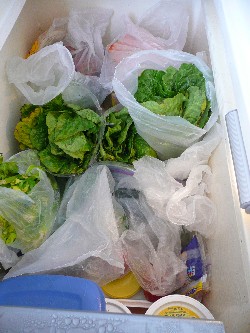
Our cooler, well packed with fresh
veggies, that we could not “dry store,”
cheeses, mayo, and fruit juice.
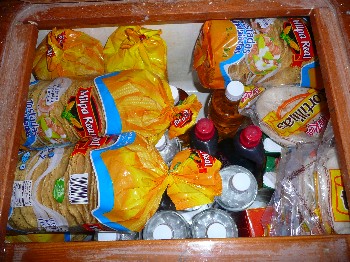
Our smaller food locker, with handy stuff like tostadas
to have with our last Herdez salsa sauce, tortillas,
club soda, fruit juice.
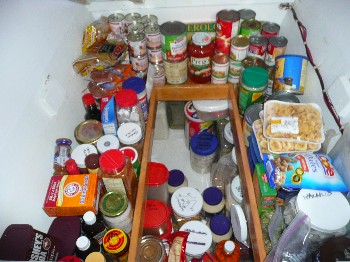
Our main food locker well organized and packed with
dry goods like flour, sugar, salt, and other baking stuff
due to my optimistic vision of baking under way, plus
canned goods, dried fruit for treats, some nuts, lots of
different seeds and beans that we could sprout or pressure-
cook (all beans are great if kept in water for a couple of
days as they begin their sprouting process, and change from
being a starch to being a very nutritious fresh vegetable.
We love garbanzo beans thus “initially sprouted” as
they make great additions to a beet or potato-egg salad, or
very tasty salads in themselves with some chopped onions
and maybe even a little grated cheese, plus salt, pepper and
a big of olive oil and vinegar.) We also carried dried milk,
a fabulous granola we discovered in Mexico, pancake mix,
lots of different pastas and pasta sauces, and some canned
veggies that I have learned how to make yummy things with
(like canned corn, canned beans, and pitted black olives).
Plus about 30 cans (7 oz?) of Herdez salsa sauce for
tostadas. We over- stocked on many things knowing we
would not be able to get a few items in Hawai’i, and
hearing that food costs in the South Pacific and
Hawai’ian Islands are high. (Have since found that food
prices, at least in Hilo, Hawai’i, are very reasonable.)
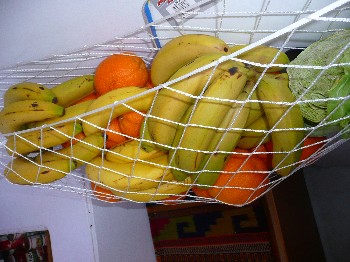
Fruit in our gear bag.
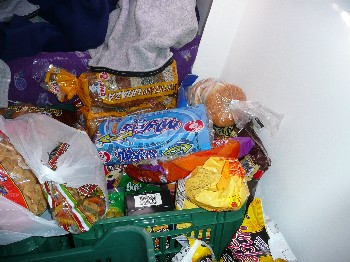
We bought three plastic cartons to carry all the
stuff that would not fit into our food lockers for this
our longest passage yet.
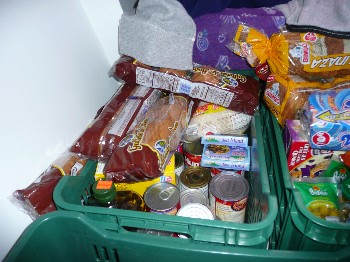
On this our last day in La Paz, we also conferenced
called to our friends back in Vancouver, and Garett called his folks Mack and
Phyllis back in Montreal. We were also delighted to receive a loving Skype call
from our friends Kasandra and Hugh Dasken as we were packing up and organizing
that last day. It was finally midnight when we had everything put away and headed
to sleep, planning on a very early get-away the next morning to leave La Paz
Harbor with the very strong outgoing tide.

A couple of days before we left, we had Matt and Ben in for
a tortilla lunch. Ben has just bought a Spencer sailboat and
Matt will be helping him to sail it to the South Pacific after
a shake-down sail to Puerto Vallarta.
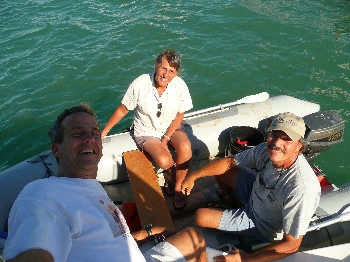
Jim and Karen from
Plum Nuts (as in “you would
have
to be “plum nuts” to buy this boat that had been
seriously damaged in the last hurricane
that hit La Paz and spend two
years fixing it up!) dropped by to wish
us well on our journey.
Garett had become good friends with
Jim while driving into town with Jim,
when he was stopped by
the Policia and told his rear light wasn’t
working. 200 pesos ($20)
later, slipped into the policia’s ticket
book solved the problem!
He would otherwise have had to
hand over his driver’s license
on the spot! These policemen are
quite creative about
supplementing what is undoubtedly
a meager income! Any
gringos make prime targets.
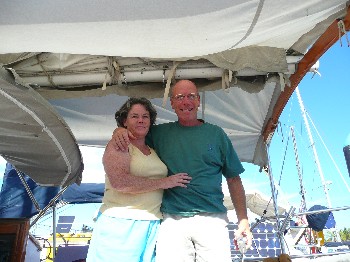
Good friends Tina and Scott
Njord Tina is a
watercolorist who kindly helps beginners one
day a week at Club Cruceros, and Scott is a very
talented musician who played keyboard and
sang with the band that had a jam session one
night a week in the restaurant across the road
from Marina de La Paz.
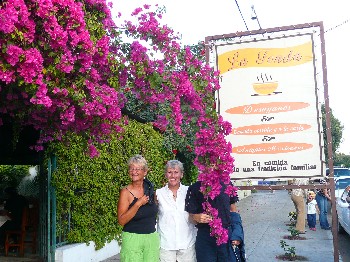
Judy Lloyd, Carllie, and David
Lloyd (hiding behind the bougainvillea.)
Sunday March 2, 2008
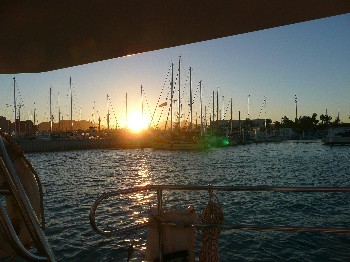
Our last morning in La Paz we awake to
get ready to leave this lovely city for a long time,
if not forever.
We were up just before dawn and retrieved our two anchors and
took the dinghy apart. Our friends Scott and Tina waved goodbye from the Marina
De La Paz dock as we passed by for the last time. Carllie’s “yoga guru”
Annie called us on Ch-22 to say goodbye, and David and Judy called to say they
would be watching for us on their breakwater at Marina Palmira. As we approached
Marina Palmira about 2 miles down the channel we saw them on the breakwater.
Judy ran along with her camera, keeping up with the boat and taking pictures
of us under sail.
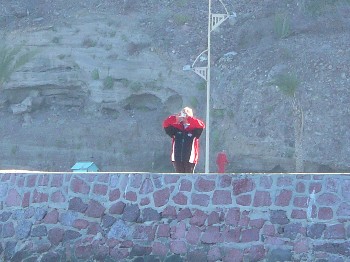
Good friend, Judy Lloyd, takes our photo under sail. It is
of course, very hard to get a photo of the crew on the boat
under sail!
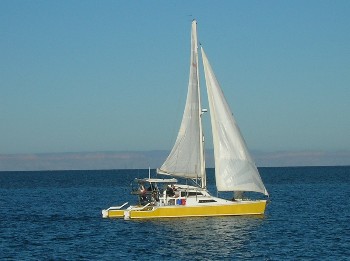
One of Judy’s photos of
Light Wave (and us) sailing
out of La Paz Harbor. Thanks,Judy!
We motor-sailed for 8 miles on another beautiful Sea of Cortez
morning and then we turned east down Lorenzo Channel as we caught our final
view of La Paz, and yelled,”Adios La Paz!” We had a lot of great times
there over the last 15 months.
Just before leaving La Paz we bought some new lures for our
ocean crossing and sure enough we caught our first fish in over 4 months while
trolling. It had been so long since we had caught a fish that at first we didn’t
no what to do to bring it aboard. We then remembered we had to gaff it. It was
quite humourous. It turned out it was a Bonito Tuna which is the best tasting
tuna, but you will never find it in restaurant unless it’s in Mexico or on the
southern California coastline.
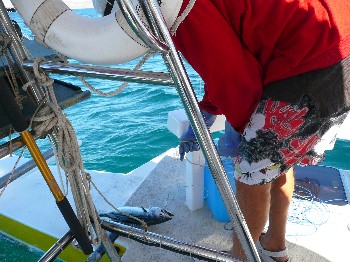
Our last catch in Mexico: a delicious bonito tuna.
We pulled into Ensenada de Los Muertos in the dark. It is recommended
never to enter most bays and ports in Mexico at night because the charts are
not accurate and there are very few lights, but we had been in there several
times before and had waypoints marked as well as a functioning and very helpful
radar.
It had been our first day of serious traveling in several months
and the 50 miles had left us bushed. (Plus, no doubt, all the walking, shopping,
provisioning, cleaning and organizing for a week before leaving!)
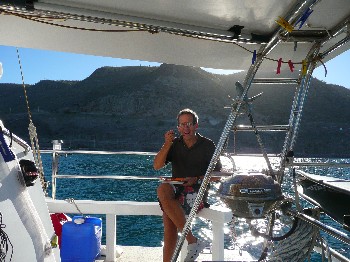
Enjoying dinner at Ensenada de Los Muertos,
amping up for our first big ocean crossing.
Monday March 3, 2008

Another vessel anchored at Los Muertos.
The wind had come up overnight so we were lucky to have gotten
out of La Paz yesterday. We were up early and I donned my wetsuit and, snorkel,
grabbed the scrub brush and went to work on cleaning the bottom of the hulls
of La Paz Harbor sludge. By noon we were ready to go and headed off in the building
north winds for the 45 mile downwind run to Los Frailes.
On this leg we retraced our trip of 15 months ago when we battled
upwind against 25-knot winds for 7 hours making our way north to Los Muertos
from Frailes, into the Sea of Cortez for the first time. It was sure nice to
now head downwind this time as the waves were so very close together. By 2 p.m.
the winds were about 25 knots and the motion was quite jerky. Fortunately, it
was a dazzlingly sunny day with the bluest of skies which made up for the motion.
We finally turned the corner behind the Los Frailes headland
into the calm waters of the protected bay with just enough light to make it
out the couple of boats that were attached to moorings with no lights on.
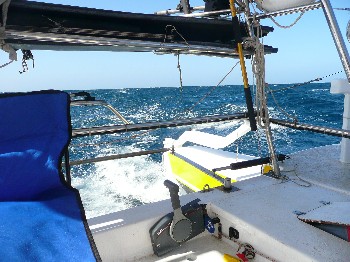
Fast sailing from Muertos to Frailes.
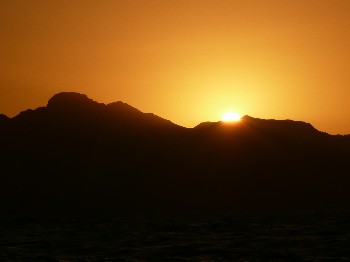
Sun sets on the dramatic hills surrounding Los Frailes.
Tuesday March 4, 2008 – Day 1- The Passage Begins
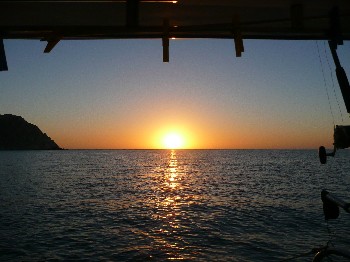
Sunrise on our final day in Mexico.
This was the day of our departure from Mexico and would be
our last night anchored until we reached Hawai’i, even though we would be traveling
30 miles along the coast until we would leave the western Mexican coastline
at Cabo San Lucas, at the southernmost tip of the Baja Peninsula.
We spent from 9 a.m. to noon putting away various gear from
the cockpit, rigging double safety lines around the cockpit, and setting up
the parachute storm anchor for cockpit deployment. By noon we had finally hauled
up the anchor and taken it off the bow and stored it in our locker. We were
now officially on our way.
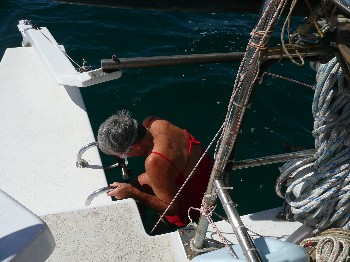
Down the swim ladder, before we tie it on
for the crossing…
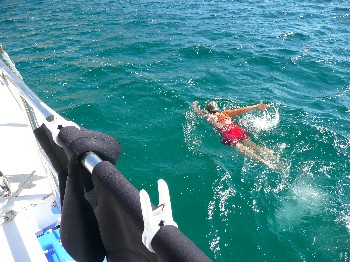
Carllie decided to swim beside the boat to Hawai’i…
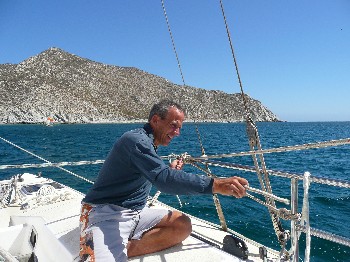
Setting up safety lines for the cockpit.
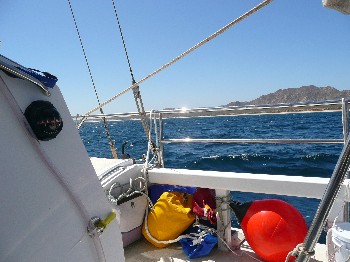
Parachute anchor all ready to go…
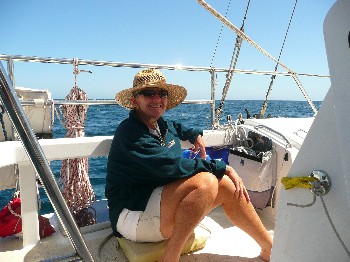
We are on our way! Everything looking good…
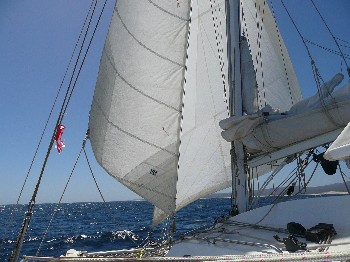
Enjoyed a great downwind sail…
After about 2 hours we slowly detected the first of the long
ocean swells that were wrapping around the Cabo San Lucas headland as we saw
the surf breaking on the shore two miles away. Suddenly, we began encountering
all these humpback whales. I was just scanning up ahead when all of a sudden
this huge whale comes shooting vertically out of the water about 200 yards ahead
of us. Wow! A full breach! I called out to Carllie and we continued to watch
this mother whale show her baby how to breach. They breached five times and
the third time they were only 50 yards from the boat. It was quite a show.

Humpback whale teaching her offspring how
to breach. We videoed it, and kept calling out,
“Don’t get any closer! We love you!”

Lowering the Mexican flag–
which is just barely hanging together
by a few threads after 1 1/2 years in
the hot Mexican sun…minus 5 months
on the hard when we took it down.
Finally by 7 p.m. as the sun set we passed Cabo
San Lucas and yelled, “Adios Mexico! Muchas gracias para todo!” (Goodbye
Mexico. Many thanks for everything.) It was now time to leave the coast as we
headed out into the black of the night. I almost chickened out as the thought
passed through my head that maybe we should go into Cabo to anchor…I was starting
to loose my nerve. We both took a deep breath and plowed on…
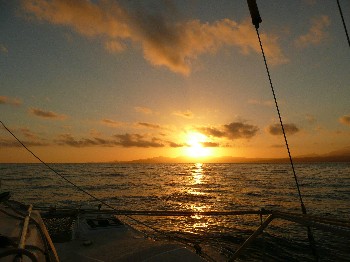
Sun sets as we approach Cabo San Lucas…
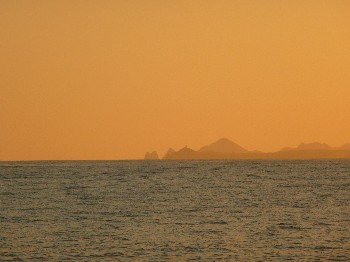
Nearing Cabo San Lucas… maybe we should pull in?
I took the first official watch from 8 p.m. to midnight while
Carllie slept. The winds were light form the northwest and so we sailed with
full sail all through the night. On Carllie’s midnight to 4 a.m. watch she called
me out at 3:30 a.m. to identify what appeared to be a huge fully lit research
ship that was not moving about 30 miles off Cabo. This was the last vessel we
would see for many days.
Wednesday March 5, 2008 – Day 2

First sunrise on the open ocean.
By dawn we could just barely see the outline of the mountains
just north of Cabo. By noon it was just 360 degrees of blue ocean. The winds
were quite light and there was only a long lazy 3 foot swell as we alternated
between motoring and sailing as we headed west in search of the trade winds.
This serene day kind of lulled us into thinking this was what we could expect
for the trip.
Carllie: A note on our navigating system: We had purchased
a multi-columned coil-bound book, and every 4 hours we entered a waypoint on
the GPS and noted in this book our lat/long, approximate wind speed and sea
state, our direction and average speed over the last 4 hours, and any comments.
Thus, if we were struck by lightning and lost all of our electronics we could
hopefully find our way with dead reckoning and the sextant to Hawai’i.
Garett’s Log Excerpt: “Carllie had the 8 p.m. to midnight
watch tonight. At about 8:30 p.m. there was a crack and bang and I woke from
my sleep. I came up on deck and we found that the screecher halyard had chafed
through and the sail had fallen in the water. We wrapped it up and sailed on
with just the jib and main. We will rig up another halyard tomorrow.”
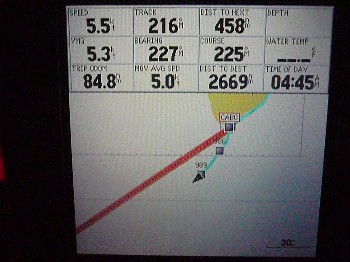
This shows our first two waypoints after
leaving Cabo. We would make a waypoint every 4 hours.
We have done 85 miles and have “only” 2669 to go.
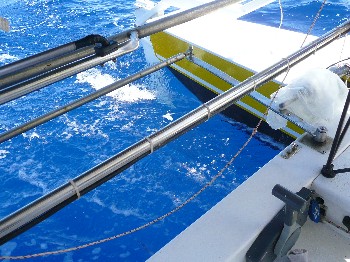
The color of the open ocean water
is a brilliant sapphire blue.
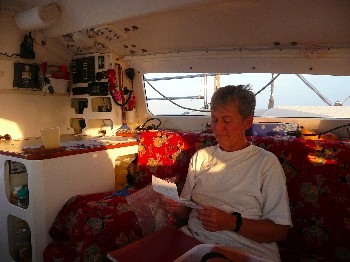
Reading one of Kasandra Dasken’s supply of letters
and notes, one for every day (she estimated!) to see
us across the ocean. Some days we were so stressed
we forgot to read them, and that is when we would
have loved them the most. Then other days we would
have a “Kasandra-a-thon” and enjoy her descriptive
humorous letters, quotations and observations.
What a thoughtful friend! You have no idea how much
those notes meant to us, Kasandra!
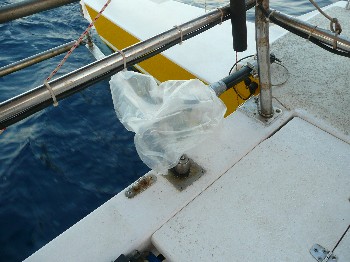
The autopilot was being sprayed and splashed with water
when the northwest swells rolled through
so we put it in a plastic bag to provide
another level of water protection.
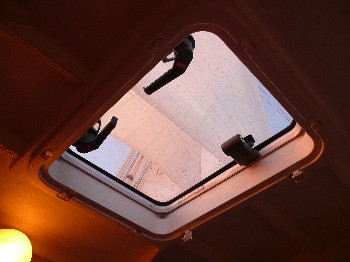
The view from our sleeping berth.
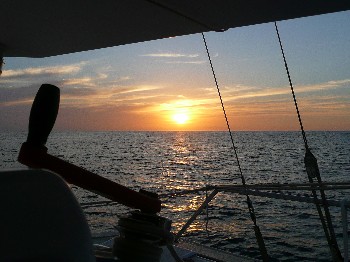
Sunset of Day 2. (Don’t worry! Although Garett took
pictures of every sunrise and sunset [ably assisted by
his loyal First Mate], I have his solemn promise that he
is not going to include them all in this update!
Thursday March 6, 2008 – Day 3, 4, 5
These three days were tough as we had north wind with a north
swell (on our beam as we were sailing west) but there was also another wave
pattern from the northwest which created a lot of wave interaction, causing
much banging and crashing. Fortunately it was sunny which made us feel a bit
better, but only until dark. (C: It was about on Day 12 that I realized that
each night when darkness fell the sound of the waves rushing up, around and
under us seemed to be magnified. Then I figured out that it was because we could
not see, and when one of our senses is shut down, the other senses ramp up their
sensitivity and receptivity. Particularly, when you cannot see, your hearing
becomes very acute.)
It was sometime on Day 4 that it really dawned on me on how
far and how long this crossing would take. We were now in it and there was no
way to turn back. I had to fight getting discouraged. I would go through these
phases where I would look at different parts of the boat, especially the rudders,
and start worrying about whether they were really strong enough to make it for
another 2,200 miles and 18 days.
The jerkiness of the motion was quite tiring and we both wondered
whether we could take it for another 2+ weeks.
We tried not to fight things and just relax with it but that
is easier said than done. We talked about how when we were in Guaymas last May
and June working on the boat in the extreme 100+F degree heat that we learned
just to relax and did not take issue with the heat, and that attitude had made
it much easier. We tried this same strategy and it did seem to make things easier
– until it got dark. Sailing across the ocean would be much easier if it was
light the whole time. When you see articles about people sailing across the
ocean you obviously never see pictures of them sailing at night. Well the fact
is that half of the crossing is at night and it is going to be dark. Everything
is amplified at night, the water noise, the sound of the wind, the motion of
the boat. It is like a whole different trip.
Carllie: When Garett “slumped” for awhile, starting
on Day 4, I had to really bite the bullet. I had been preparing myself to be
cheerful, happy and upbeat the whole way across, like my good sailing friends
Marni Siddons, Melissa Davids, Judy Lloyd, Susan Leader and Miriam Brooks, but
I had never envisaged Garett losing his unstoppable optimism and confidence.
This was a tough time for me, and as I say I had to really suck it up and not
bawl out, “Yaaaaaagggggh! What are we doing? Let’s turn around.” (Fat
chance. Turning around after 4 days at sea when you are running downwind, however
rough, is simply not an option unless you are Pete Goss sailing a 60-footer
saving Raphael Dinelli in the 1996 Vendee Globe!) I did not succumb to these
base instincts, however, and tried to encourage Garett and keep cheery while
I did so myself; got out some taped philosophy classes given by a good friend
to listen to; sang some songs, etc. Meanwhile, my stomach was clutching a bit.
So finally I said to my darling bouncy irrepressible mate, “Garett, you
have to be cheerful and confident. Because if you are not, I am going to jump
overboard.” (Or words to that effect…) He regained his equanimity, and
we both worked very hard to keep it together. Probably 99% of facing any challenge
successfully is your attitude.
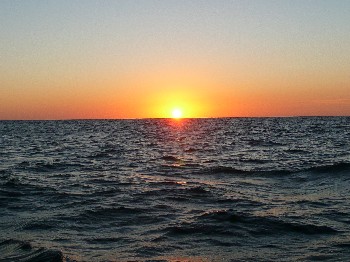
Dawn of Day 3.
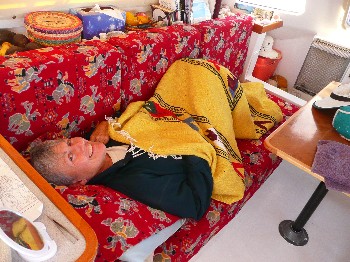
Carllie having a happy nap. (Nap and sleep time for me was
the best time as I could totally zone out. When you are
unconscious, you don’t know where the heck you are.
It’s bliss! Seriously, I am sure Garett got the same
respite from rough reality when he was sleeping…
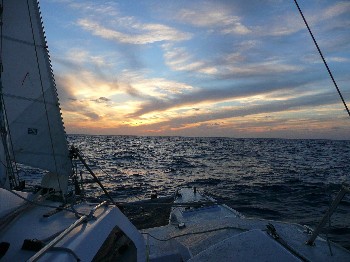
Sunset on Day 4 and the first hint of clouds since
we left Mexico.
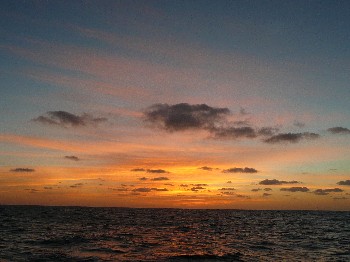
Sunrise on Day 5.
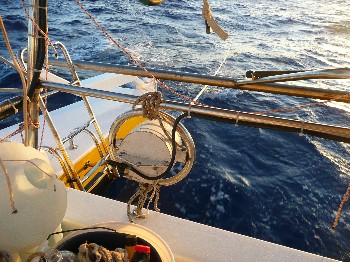
We used our Aquair towed generator
every second day, at first
and as it got cloudier, we left it in
almost all the time. It worked
great and was vital as the trip
went along and we had
so much cloud cover that our solar
panels were not charging the
battery very much and our
engine wouldn’t start
because the starter had
shorted out (explanation later).
In any case, we only had
enough gas to motor the last
50 miles or so, if we desperately
needed to. We certainly
could not motor long enough every
day to charge our battery
as we do not have a diesel
engine and our outboard only
charges our battery at 7 amps.
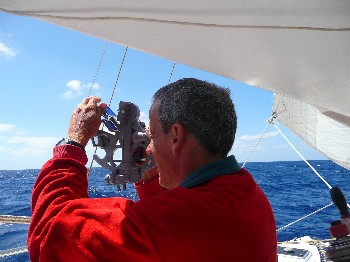
Garett had purchased a plastic sextant
as a backup
to our two GPS’s. He did his first noon site on Day 5
and was happy that I calculated our location to
within 3 miles.
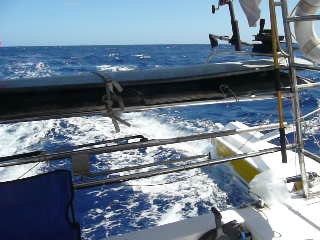
Sailing fast on Day 5.
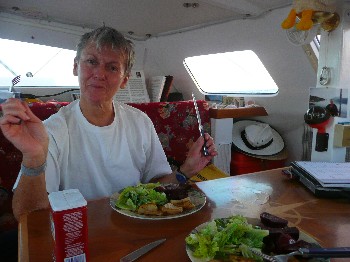
Another great sit down dinner from Carllie.
Caesar salad with baked potatoes. (Notice the
cheery face???)
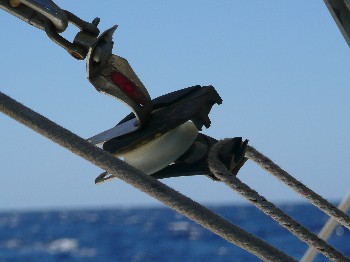
In the middle of the night I heard this “BANG!”
I went on deck with my flashlight and
found that the block on the boom vang had
exploded. It was a little undersized. (C: Thankfully
we had another, much more heavy-duty block among
all of our back-up equipment.)
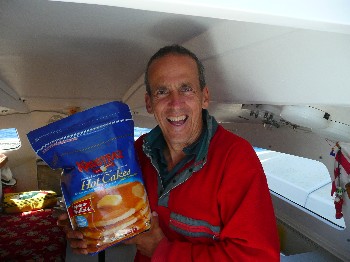
Pancake time!
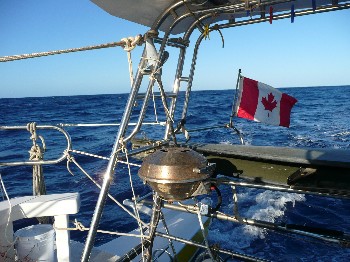
Ho-hum. Another day at sea. At least the sky is blue!
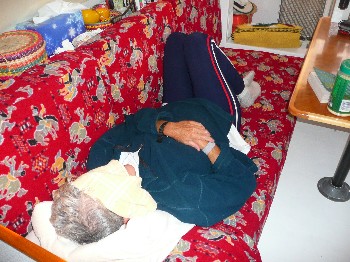
Tummy a little unsettled, cloth over eyes helps with
naps during the day…
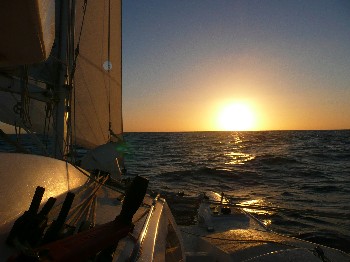
Sunset of Day 5 – Still blue skies.
Sunday March 9, 2008 – Day 6
Early this morning the winds finally shifted into the northeast
and we were now in the trade winds. Wow! What a difference a day makes! We were
now sailing on a broad reach and the motion was so much better. The wind was
10 to 15 knots and so we set up our screecher on the whisker pole to starboard
and our drifter to port. We were wing on wing and we were doing 5 to 6 knots.
The skies were sunny. It was just such a difference from Days 3, 4, and 5. It
was like a different trip. We were so relieved.
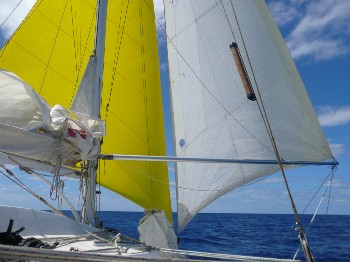
Now this is more like it! Hoo boy! We won’t
have to touch the sails the whole way to Hawai’i, right?
At least that’s what everyone says…
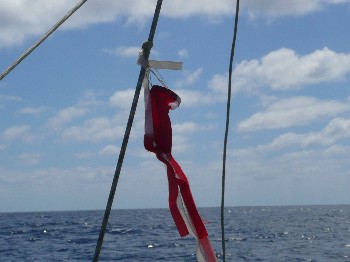
Our tiny “Canadian flag” wind sock, given to
us by Lorill Garner, got a tad tangled by the end of the trip!
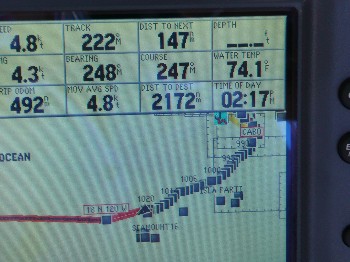
You can see the little squares which
are the waypoint marks we make every 4 hours.
“Only” 2172 miles to go.
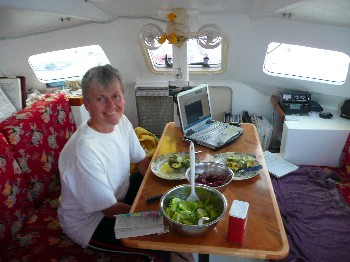
Another great dinner.
We had Caesar salad for the first 9 days,
savoring our Romaine lettuce and Carllie’s
great Caesar salad dressing until the Romaine was
all gone.
Monday March 10, 2008 – Day 7
Another great morning as we continued to sail wing on wing
as the winds seemed just a bit stronger and we even hit 9 knots by noon.
At about 5 pm Carllie got the boat up to 10.6 knots (C: and
hollered, “HELP!”) and we decided it was time to reduce sail so we
took down both sails and the pole and set up the jib for the night.
While having our regular sit down dinner at 7 p.m. we listened
into the evening cruiser net of the boats that were crossing to Hawai’i or the
Marquesas (most to the latter). We heard our friends Scott and Tina from La
Paz send us a blind hello and good wishes, and were much heartened. It was sure
nice to hear Scott’s voice. The net controller would also say hello each night
to us from the fleet. They knew we could not respond because we do not have
transmitting ability on our Single Sideband radio.
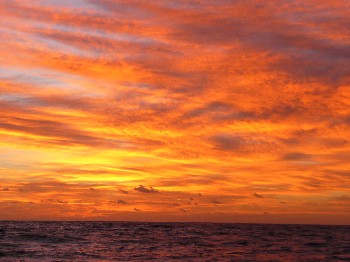
The sunsets became increasingly more dramatic
with the cloud cover…
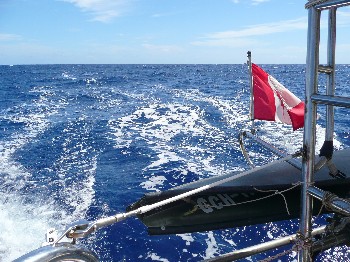
The deep deep blue ocean just goes on and on…
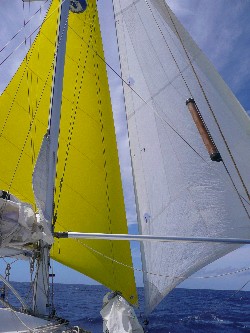
Still enjoying a downwind sail.
wing-on-wing aided by our
whisker pole as we were not going
dead downwind
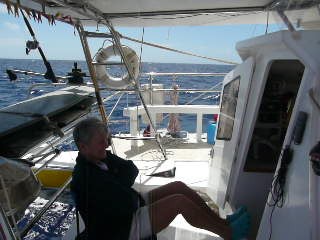
Garett had encouraged me to give away all of
my novels before we left La Paz, as I had become
rather addicted to reading novels, which while enjoyable
is a great time-waster and not much help to achieving
one’s goals. I agreed and complied. So on this long
journey, I had nothing to read (except writing books,
the Oxford Dictionary and cruising guides and
somehow I could ot bring myself to concentrate on
those) but two new books my friend Kasandra
Dasken had sent me for my birthday plus
Charles Darwin’s “Voyage of the
Beagle,” his account of his five-year journey to and
around South American, the Galapagos Islands, etc. He
was a biologist, and at that time, of course, they had no
cameras, so he describes in excrutiatingly minute
detail absolutely everything he sees and experiences.
It is very interesting…to a point. But when he goes
on and on and on comparing one type of beetle to
another one gets a tad bored. I am still only half-way
through the book, and I am surreptitiously
accumulating a little store of used books passed
on by other cruisers, so
that I will have “Great Escape” stuff to see me
back across the ocean to Vancouver in July!
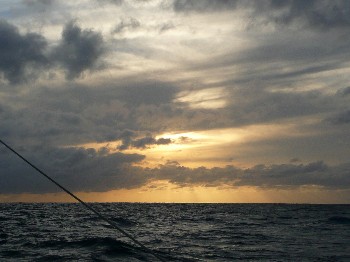
Sunset seems to indicate a change in the weather.
Tuesday March 11, 2008 – Day 8
We now have been out of sight of land for a whole week. Even
with all the work to get this far we still have at least another two weeks to
go.
Today felt like we were on a completely different passage from
the easy motion of the previous two days. The winds were now 15 to 20 knots
from the northeast but now there was another wave pattern from the northwest
which intersected our local waves at 90 degrees. This again made the boat motion
uncomfortable.
Carllie and I had often read in the books of people cruising
in the trade winds things like “we set our sails and never touched them
for two weeks.” They must have been sailing somewhere else in the world
in some other kind of trade winds because, although the winds were consistent
in terms of direction, the wind strength would go up and down forcing us to
change the sail configuration several times per day.
Today we saw a freighter about three miles to the south. This
was the last boat we were to see for 12 days.
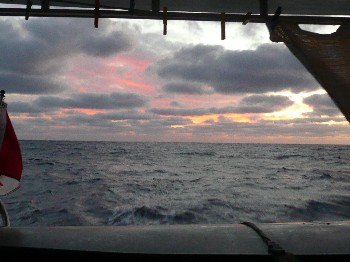
Sun sets on a grey sea.
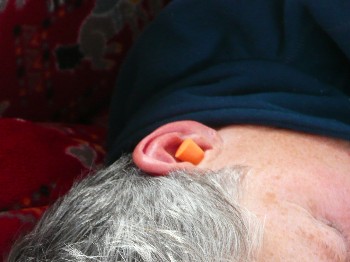
Indispensable ear plugs made sleep possible.
(C: Hey! You’re supposed to ASK before you take
close-up pictures of me!)
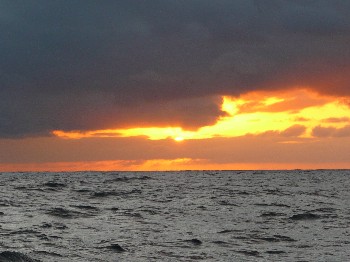
Almost dark…
Wednesday March 12, 2008 –
Day 9
We made 129 miles yesterday, our best day yet and today we
continued to sail along at good speed.
Today was “Cook’s Day Off,” so I made all the meals
for the day. Nothing like Carllie’s cuisine mind you.
Today’s Menu:
- Breakfast – Granola and fruit salad
- Lunch – Pillsbury Cinnabun Bun (come in those rolls that
you break open with a pop and then bake
- Afternoon snack – Popcorn
- Dinner – Steam-fried zucchini – Flor De Cabeza Canned soup
– Carrot and tomato slices – Banana bread.
(C: By the way, each day in his journal Garett made a note
of what our meals consisted of. In retrospect, it’s pretty interesting.)
When night came, for some reason we were both a little anxious
as the motion and the sounds are amplified. We continued to struggle to stay
relaxed and not fight the waves and the ocean.
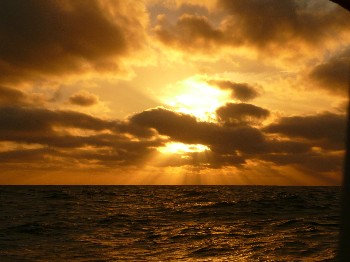
Life’s gift to us each day was a
spectacular sunset.
Thursday ,March 13, 2008 – Day 10
We had another rough night, but feel good during the day. A
funny thing also happened last night. In the middle of my 2 a.m. watch, I could
hear the engine trying to start while I was in the cabin. At first I thought
that was kind of strange that Carllie was up and why was she trying to start
the engine. (Later Carllie told me that during her watch she had also heard
it trying to start from her perch inside the cuddy cabin and thought that for
some reason I had come outside and tried to start the engine.) I went outside
and of course she was not there but asleep in the port hull. Was it a ghost?
I pulled off the engine cover and saw all this green electrolysis oozing from
the power switch. There must have been some type of short so I turned off the
cockpit power switch. In the light of the morning I examined it further and
found that that the starter relay had shorted out from water coming in through
a hole in the side of the engine that been eaten away from another water-induced
short, presumably caused by all the waves surging up within the engine well.
I disconnected the power to the engine from the battery to prevent any more
damage, and hoped I would be able to start it with the hand starter when we
got to Hilo Harbor. Not good.
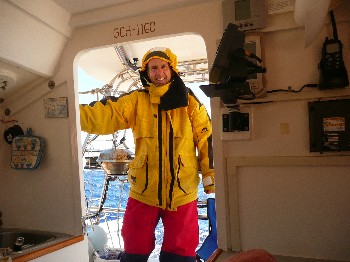
Garett back to his cheery self, handling
whatever comes along with aplomb.
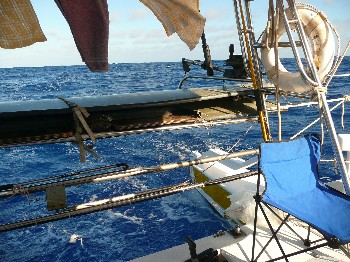
It is handy to have a long line run through the stainless
loops we have welded under our hardtop, as I can
dry tea towels and underclothes under way.
Friday , March 14, 2008 – Day 11
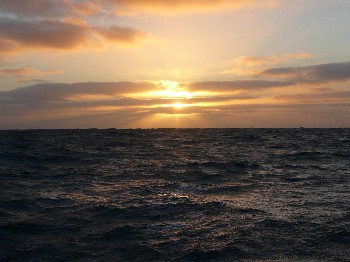
Sunrise…
We were both still struggling to keep ourselves
up. Here is an excerpt from my journal:
“After 10 a.m. I did my morning breathing
exercise routine and relaxation tape but was still a bit down. I must be positive.
Whatever can go right will go right. Carllie convinced me to take a shower
[even though it was cool and we had about 10 knots of wind blowing on us in
the cockpit]. It really wasn’t that cold. It felt great to air dry. I
am back into it. At noon we completed our best day run so far of 133 miles
for an average speed of 5.5. Our next objective is the halfway point in 160
miles. Breakfast: Cantaloupe, Lunch: Tuna melt sandwiches and taco chips.”
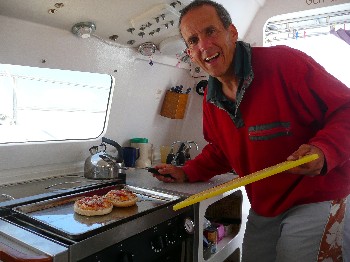
Garett is “back into it” making his tuna melt sandwiches.
Excerpt from Carllie’s journal:
“Sea state is hard to work with as
we have big swells coming from both the NE and NW. When they converge under
us, big slams result. Garett is not so sure as he usually is. This is our
11th day since Cabo San Lucas, so we are almost halfway there. We really hear
the water rushing at us, under us, and pounding the boat, and altogether it
is unsettling. How to cope with 10 more days of this? We can only hope that
the north swell will cease, as it must be caused by a storm up north anywhere
from California to Vancouver Island. Best thing to do is to be constructive
and just do our best to help Light Wave meet this challenge. Judy
and David [Lloyd] sailed a Prout to Florida from the Canary Islands, and it
has even less clearance than we do. They said it was slamming the whole way,
but, they said, ‘the Prout is a tough, well built little boat!’ Well, so is
Light Wave!”
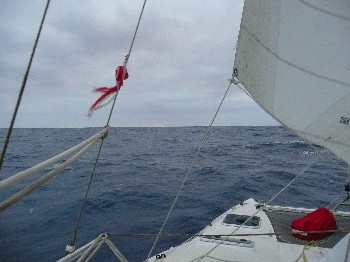
No sunset tonight – just lots of grey cloud.
Saturday, March 15, 2008 – Day 12
We were getting close to the halfway mark and were getting
quite excited.
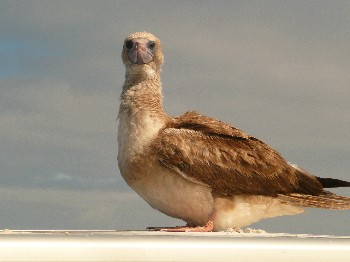
This booby bird had been circling the boat on and off for
the last 2 days and finally parked himself on one
of our solar panels. (You can already see the poop
accumulating under him!)
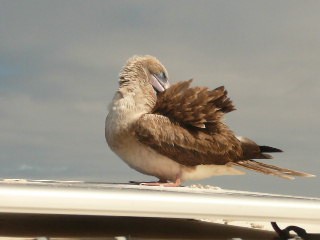
He was either preening himself or sleeping for
the 3 days he was on board, rocking back and
forth when we were tethered to the sea on our
parachute anchor. He made a mess that undoubtedly
would obscure our solar panels, but Garett did not
want to chase him away. I was pretty fond of him
too. Finally, when we pulled out of the “Black Hole”
where we were pinned to the ocean, he flew back
once to check us out from the air, but never re-appeared,
and when it got a little calmer Garett climbed up on top
of our hardtop and cleaned off the solar panels.
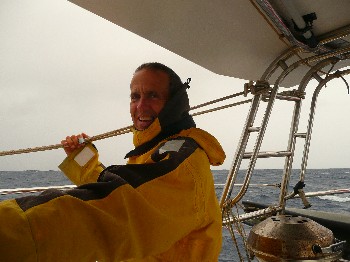
Optimistic that we are getting there.
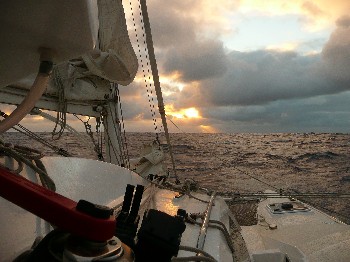
Ominous sunset as we reach the halfway mark.
Finally at 6 p.m. we came to the halfway point
at 1,350 miles and had a bit of celebration, with one piece of organic chocolate
each. No sooner did we finish than we spotted our first rain squall to the northeast.
Up until that time the skies had been predominantly blue and sunny with just
the odd cloudy patch.
As the skies darkened the wind built through the evening after
a series of squalls came through so by 11 p.m. it was 30+ knots. I was on watch
now and had no sail up and we were still doing 5 knots under bare poles after
we had put out our drogue off our starboard aft quarter to slow us down and
prevent us surfing down the ever-steepening waves.
Every now and then a wave surged up behind us and break, sending
spray into the cockpit with a crash and bang. Carllie would open the cockpit
door to see if I was all right. There was no moon and it was very dark. (In
these rough conditions I also insisted he hank onto the eyeplates bolted and
epoxied onto the back of the cuddy cabin, and if I was going to be sleeping
the understanding was that he would never go forward to work on the foredeck.
He had to call me and I would come out to watch him with a flashlight.)
By midnight the conditions had deteriorated to the point that
we had decided to deploy our parachute storm anchor off the bow to stop us.
Although we had always planned that if we needed the parachute anchor we would
deploy it from the starboard aft hull and had it set up to do so, we didn’t
think we could because the drogue was already deployed from the starboard stern.
The only problem was we had to retrieve the drogue first as we did not want
it to get tangled with the parachute. We tried all types of knots to get a second
line on the drogue line but all the knots seemed to slip. After many unsuccessful
retrieval attempts and the loss of my LED headlamp overboard, we decided to
have rest. By 4 a.m. the winds were 35 knots and we concluded that we had to
risk putting out the parachute in the water with the drogue still out on the
port side.
We checked all the lines and bags and then in order we put
out the big float (with a trip line running back to the boat and a big red float
to mark it), the parachute in a self-deployment bag, and then the 350 of super-stretchy
nylon rode in its own self-deployment bag. Everything seemed to go into the
water fine but we didn’t swing bow into the wind as we should. We then realized
that the drogue was slowing the stern from swinging around to face the waves.
Slowly but surely,
Light Wave swung around into the wind, and we breathed
sighs of relief.
All this time the waves are crashing by and the wind is howling
in the deep blackness of the night. I then had to attach my harness to the safety
line and go to the bow to rig up the bridle to the port bow but first I had
to get Carllie to release the screecher halyard so I could fold up the A-frame
bowsprit that it is attached to. Somehow we managed to get everything back on
deck and then I ran the line over for the bridle. I was now also able to slowly
pull in the drogue. It took about an hour but now the boat virtually stopped
and was now anchored to the surface of the water but rising and falling over
every fast moving wave in between the odd rain squall. We now waited and tried
to sleep but couldn’t.
Sunday March 16, 2008 – Day 13
At 7 a.m. we listened to the morning Amigo Net for boats in
Mexico and for some boats that are crossing to the Marquesas and Hawai’i. Even
though the official weather forecast was for “20 to 25 knot winds”
we heard crew from another boat,
Gia (Desiree and Damon whom we later
met in Hilo and who have become friends) at 7 a.m. on the short wave radio who
was nearby also reporting 35 knot winds. The weather forecast did not seem to
be changing. We now had a new dilemma. The usual strategy is to wait safely
tethered to your parachute anchor for the storm to blow through in 12 to 24
hours; however, this was not a conventional storm system but a huge unmoving
area of “very reinforced” trade winds caused by the “La Nina”
weather conditions. How long would these steady winds last: a day, two days,
a week, a month? We then came to the conclusion and our first and only axiom
borne of this trip that “There is no point in being safe if you can never
leave.” We decided to just wait the day and see what would happen.
Hour after hour we rose up down over a 12-to-15 foot wave
every 10 seconds. It was hypnotic. Most of the waves would not touch the bottom
of the nacelle, but every now and then a really steep one would come racing
by and seemingly explode on the bottom of the nacelle. We would look at each
other and wonder how many of those big hits the bottom of the nacelle could
take. I even got out some bits of plywood and screws in case I had to patch
something together. We were a little worried.
Every couple of hours Carllie and I put our storm gear on and
harness ourselves to the safety lines that ringed the boat and go onto to the
bows to check for chafing on the bridle lines.
We felt trapped. How did we get into this situation? (C: At
one point I jokingly screeched at him, “Whose brilliant idea was this anyway???”)
We talked it over and concluded we just had to do what we could to keep the
boat safe and we would somehow work it through.
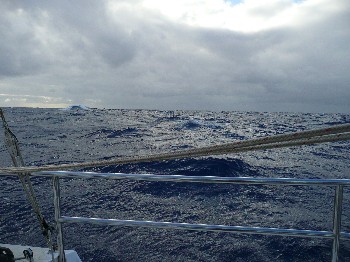
The bleak sea when we were anchored on it mid-ocean.
Looks a lot less rolly than it was.
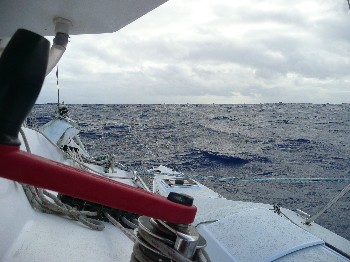
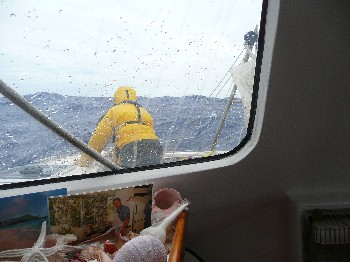
Out on the bows checking the chafe gear
on the bridle arms.
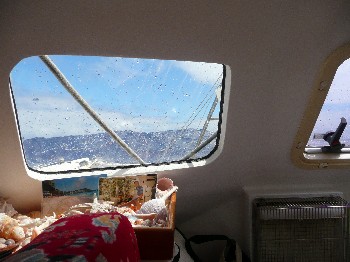
It would clear up for a while but the wind still blew.
Often, spray washed over the front windows.
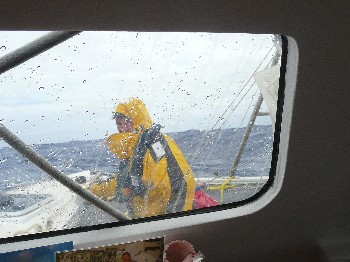
But then the rain returned as
another squall blasted us.
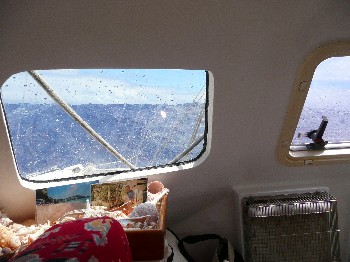
Wave is fast approaching. You can see
the parachute anchor in the wave on the far
right side of the port (left) window. When
we eventually retrieved it, the lines were
partially wound
around and we realized that in fact it had tangled
with the drogue when we deployed it, and had
not been fully opened. It should have lain
horizontally, big in the wave, like a big
sky parachute. But it did the job anyway,
thank goodness!
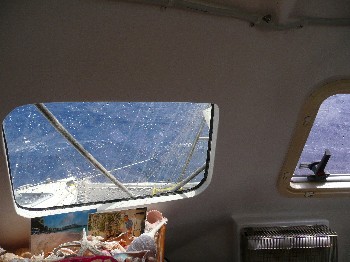
Big wave directly in front of us. Parachute will pull us over
it.
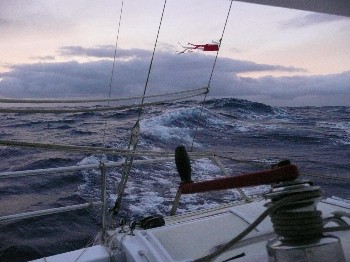
Fast moving waves zing by the port hull. (Note Lorill’s
“wind sock” blowing on the rigging!)
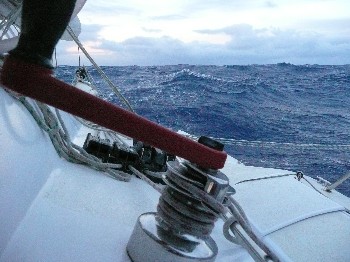
You can’t quite see the parachute but it is out there,
350 feet to windward.
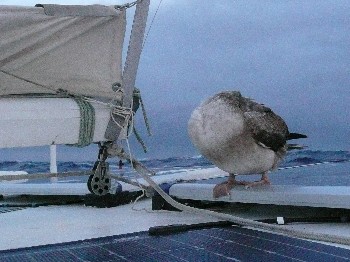
… and through it all our friendly
booby bird just slept away. We made it our mission
to somehow get him to Hawai’i.
Monday, March 17, 2008 – Day 14
By the 8 a.m. of the next day the official forecast had not
changed (still saying 20 to 25 knots) but the actual conditions seemed to be
ever so slightly better, so after 28 hours being “pinned” to the
ocean we just barely decided to retrieve the parachute anchor and start sailing.
We were unsure if this was the right thing to do. Were we being too impatient
just to get moving again?
It took us about an hour to winch in the trip line and parachute
and line all back on the boat. For about 5 minutes we were sideways to the waves
but we just rose up and down the waves. By 9 a.m. we were sailing again in the
sunshine. Boy did we feel good to be moving again! Unfortunately, about an hour
later we also realized we were only still only half way to Hawai’i and we faced
another 1,350 miles and 11 to 12 days of sailing…
We sailed all day at 6 to 7 knots in the sunshine with just
the jib, but by nightfall the winds were still 25 knots and we were surfing
down these large 15-to-20 foot waves. We rigged up some new lines and were able
to set the drogue off a bridle directly behind the boat. This made all the difference
in the world compared our use of the drogue on a single line off the starboard
aft quarter 2 days ago. Now it kept the boat from sluicing from side to side
as well as keeping our speed from surging. We had learnt something very valuable
about sailing
Light Wave in these “reinforced” trade wind
conditions. We now realized that we would have been able to sail with the drogue
in this configuration two days ago and might not have had to deploy the parachute
anchor, and would have made about 100 miles in 24 hours instead of just 18.
Tuesday, March 18, 2008 – Day 15
We were in a little better spirits today after covering 120
miles in the last 24 hours. We had a great day after feeling like we were lost
forever in this black hole in the middle of the Pacific.
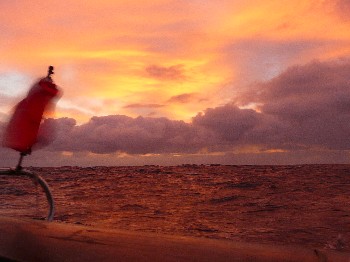
Sunrises are always good. Light is good!
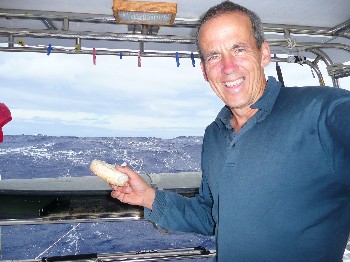
Garett skipping our moldy bagels on the ocean. (It was great
fun!
A new sport! I actually got three skips on one.)
I started making a list in the morning of things to do for
the day. This seemed to help me keep positive.
Wednesday, March 19, 2008 – Day 16
Log excerpt:
“We had a pretty good night and kept sailing with the
jib and holding 270 degrees so we are aiming for Hilo. It was almost a full
moon last night behind the clouds so it was quite bright out. We got away
from our usual watch schedule last night as it was impossible to sleep in
the hull because of the noise. We are at 1,120 miles to go.”
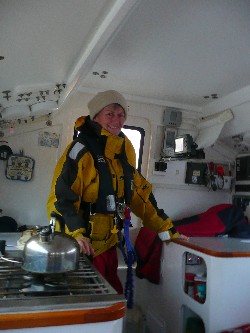
Carllie on watch.
Excerpt from Carllie’s journal:
“We have finally accepted the endless
movement of the ocean, and have gained confidence in LW’s ability to handle
it, provided she is set with the right sails. Through our ordeal of being
“pinned to the ocean” like bugs, being jack hammered by it, we have
learned how to set up the drogue to control LW’s speed and motion–not to
stop her! We have gone for 15 days now, 14
of them without seeing another vessel except one freighter and the lights
of one small vessel in the distance. Nights are loooooong and always challenging.
Now I am trying to sleep more during the day as unless I sleep in the cuddy
cabin the noise makes sleep difficult. When we cannot see anything because
of the dark, dark sky and sea, our sense of hearing becomes magnified, and
sounds like the wind singing in the rigging and the waves washing up, through,
under and around the boat, become magnified and scary, even though often conditions
are no different than they were during the day. I have to re-establish my
constructive habit of working with my goals.”
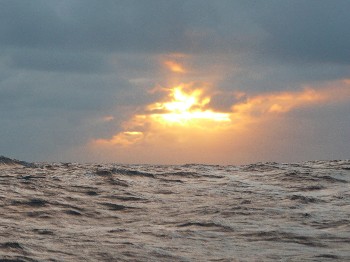
Cloudy sunset to another bumpy night.
Thursday, March 20, 2008 – Day 17
We got back into our regular watch schedule last night as we
started to use the big ventilator fan as a white noise generator. We are now
down to triple digits of 995 miles to go! It was very heartening to pass the
1,000 mile (to go) mark, and Carllie called down to me in the sleeping hull
to tell me when we had passed it.
I started downloading weather faxes over the short wave radio
and this gave us quite a bit of weather information.
Friday, March 21, 2008 – Day 18
We are now at 840 miles to go and at 120 miles per day we are
estimating we will be in Hilo in 7 more days. This is a long trip.
Air temperature up to 70 F and water is 72 F so it is starting
to warm up.
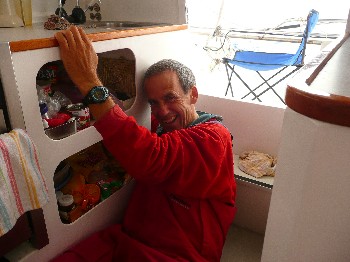
Fixing the salt-water pump, first of about 4 times.
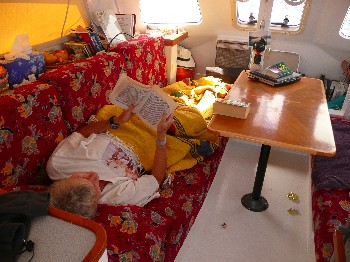
Carllie re-reading the two novels we have on board
for the second time.
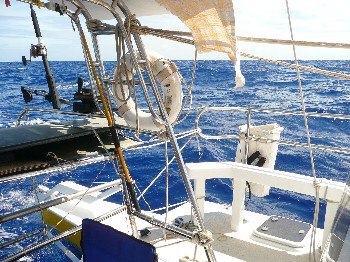
Well, it
looks pretty
.
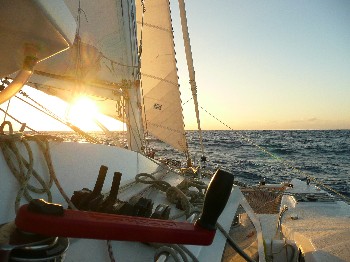
Clearer skies bode well for a smoother night.
Saturday, March 22, 2008 – Day 19
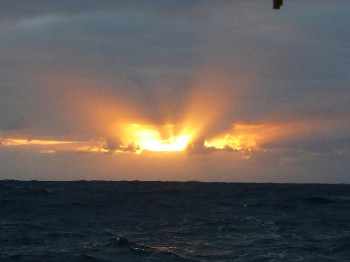
Cloudy dawn.
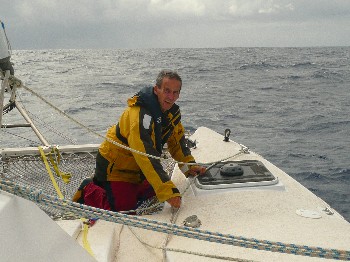
Rigging up the whisker pole.
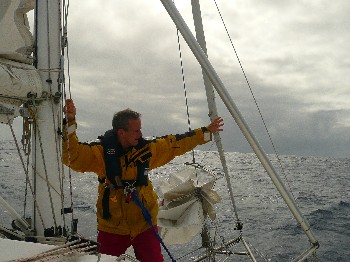
Extending the pole.
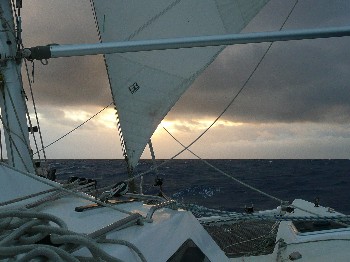
Jib set up to windward for the day.
This became a constant as we could then
raise and lower the main to leeward if the
winds dropped.
Sunday March 23, 2008 – Day 20
Just 5 more days to go. Today’s chant was “Five more nights!
Five more nights!”
The autopilot pin broke again so we quickly put in a screw
as a makeshift pin to keep us going. The last screw lasted 9 days and 1,000
miles. This was the third time this happened, but I was prepared for it and
have lots of the right size screw aboard.
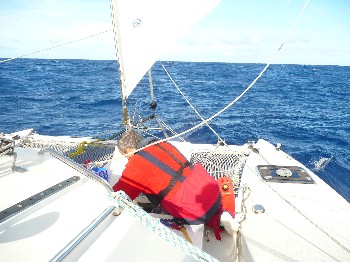
Propane tank #1 ran out so Garett had to
go forward to switch tanks. He is
always hanked on when he goes forward
in the middle of the ocean and/or in
heavy weather.
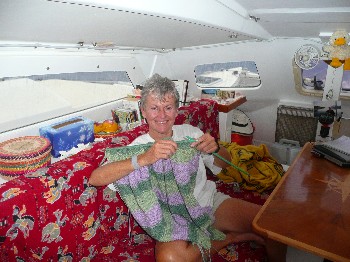
Carllie knitting a baby blanket for
Caring Hearts back home. Note the
Sea Band for acupressure relief of
motion sickness, on the right wrist.
Electronic Relief Band that zaps the
acupressure point is on the left wrist.
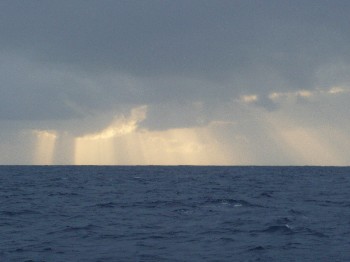
A spectacular but gloomy sunset.
At midnight on her watch Carllie threw open the sleeping hull
hatch and and excitedly yelled, “There’s a sailboat behind us! Right behind
us!!!” This was a big event as we had not seen another boat in almost two
weeks, and never a sailboat. We quickly turned on the VHF radio (with a range
of 25 miles) and on channel 16 hailed them. Much to our surprise, it was Don
on “Sabbatical 2” who is from B.C. We had met Don in La Paz before
we left. Coincidentally, our friends Richard Woods (designer of
Light Wave)
and his partner Jetti had crewed with Don from San Diego to Cabo San Lucas,
then took the bus to La Paz where they visited with us. Three weeks ago I had
joked with Don that maybe we will meet out in the middle of the ocean. We chatted
on the radio about our respective crossings and the strong winds. Don was solo-sailing
his 48-foot Maple Leaf sailboat that he had built (beautifully) 30 years ago.
He is 76 years old. Truly amazing. He was doing about 2 knots faster than us
so we figured he would get to Hilo in 4 days while it would be 5 for us. It
was pretty sad to watch his boat and red nav light pass us though.
Monday, March 24, 2008 – Day 21
We woke up to cloudy overcast and rain , and we slowed the
boat down for a few hours but we didn’t have to put the drogue out or anything.
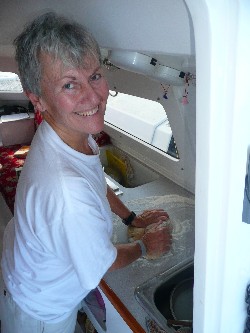
Happy Carllie making her wonderful
Irish Freckle bread. It rose beautifully, and
I was so hopeful about it. It is a great recipe
and makes great toast. However! Even though I
had pre-heated our Force 10 propane oven with
both the oven and broiler jets on, when I
put the 2 loaves of bread in on my big stainless
cookie sheet, as always, the oven temperature
just continued to drop, and drop and drop. Finally,
at 200 degrees, I told Garett the oven burner
must be off. Sure enough, he checked it and it
was out, and we could not re-start it. Some time
for an oven glitch! Just when we really needed
a pick-me-up with home-made bread and raisin toast.
Garett wouldn’t let me throw it overboard and made
what he called “biscottis” with it. Yuck.

Carllie’s wonderful bread flattened
into pancake biscottis by a non-
functioning oven. My hand indicates
how high the bread had been before
it fell. Thankfully, Garett has cleaned
the jets now and it works again.
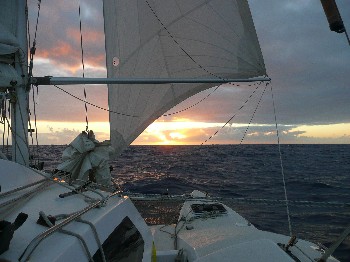
Light Wave dependably keeps sailing
day after day.
Tuesday, March 25, 2008 – Day 22
Garett’s journal:
“Had pretty good sleep last night during midnight
to 4 a.m. off watch. Looking at ETA of 1:36 pm on Friday, just 3 days to go.
Got up to 10.2 knots this morning with screecher and jib. Now with just jib
we are doing 5 knots. Seas seem a bit better. I have to take apart the salt
water pump apart again. Played scrabble with Carllie at 5 p.m. Carllie’s Palm
Pilot has died and she can’t play on it anymore.”
Carllie: The Scrabble game on our Palm Pilot was my soother
throughout our trip, from July 2006 to now. I am so good at Scrabble now, I
amaze myself. Sometimes I get 2 seven-letter words in a game, and often I beat
the “Expert” level computer Scrabble player. I curse him other times
because he blatantly cheats. So lame. Anyhoo. Ah sho do miss my handy-dandy
though old Palm Pilot with its never-ending Scrabble games. Garett can’t fix
it. Costs too much to buy a new one. Sigh. Guess it’s back to knitting. Seriously,
sometimes I just cannot put my thoughts inside my brain to concentrate when
we are doing a rough crossing, and Scrabble on the Palm sooths me to the point
where I fall off to sleep. If I try to listen to a Spanish lesson or Philosophy
class, my thoughts turn too much inside my head somehow and I begin to feel
a little woozy. I will keep working on this serious flaw in my nature…
Wednesday, March 26, 2008 – Day 23
Two more nights! Two more nights!
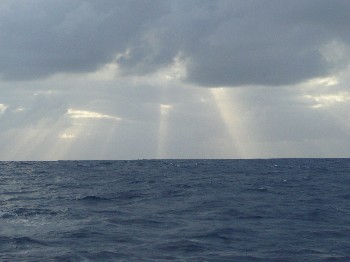
Looking good!
Thursday, March 27, 2008 – Day 24
Garett’s Journal:
“One day to go! I took a look at the engine and
tried to see if could hand start it. When I got into the engine cover there
was alot of electrolysis. Sure hope I can fix it. I managed to get the engine
hand started with some Quick Start ether spray. Ran engine for 30 minutes.
Good, we won’t have to be towed in.”
We were hoping we would see land but it was quite hazy and
showery.
Carllie’s journal:
“One more night! Then, after only a few hours, we
can…STOP! No more sounds of waves and water rushing at, around and under
the boat! It really gets to you, especially at night when one of your senses,
sight, is useless. Sound becomes magnified. Garett thinks his nervous system
is more relaxed, stiller, because we are not
being bombarded with sounds and all kinds of electromagnetic waves from radio
waves to micro waves and cellular waves. Perhaps that is why our appetites
have diminished and food holds far less appeal. We have a lot of candies [on
board], and have eaten hardly any of them. I have been making cooked beet
and cooked potato-yam salads, using boiled eggs and the secret–chopped sprouted
garbanzo beans! They give the salads a little nutty texture and flavor. I
spent an hour making Irish freckle bread the other day, only to find that
the oven has stopped working! Garett says we will get it working–probably
after we arrive in Hilo.”
Friday, March 28, 2008 – Day 25
We both had good sleeps on our final night at sea, probably
because we knew the end was in sight. At dawn, 7 a.m., I spotted a sailboat
about three miles off to the southwest. I thought it might have been the other
boat,
Gia, that was a about 200 miles behind us when we were at the
halfway point, whose crew we had heard on the shortwave radio. Then I saw a
maple leaf on the sail and realized it was a Canadian boat and it looked like
another Maple Leaf make like Don’s boat,
Sabattical 2. In fact it looked
like Don’s boat, but it couldn’t be! We thought he must be already in Hilo,
having passed us at over 7 knots, we figured, to our 5.5 five days before.
As we got closer and closer we realized it was
Sabbatical
2, which didn’t make sense. We feared that had something had happened,
that he might have fallen overboard or maybe was injured because we couldn’t
see him and we couldn’t raise him on the VHF radio. We finally got close enough
that we spotted him steering in his big centre cockpit (he is a fairly small
fellow) so we knew he was all right. We called out to him and, just barely over
the sound of the wind and waves, we heard his response. It turned out his autopilot
had stopped working and so he had had to hand steer for 72 hours straight! Don
is 76 years old, solo sailing, so now Carllie was even more concerned. We finally
talked to him on the radio (he couldn’t go below where his radio was for long
as he had to hand steer), and when Carllie asked he told her he did not want
us to call the Coast Guard and ask them to give him some assistance. In fact,
he did sail into Hilo harbor shortly after us, and after a full night’s sleep
he was fine.
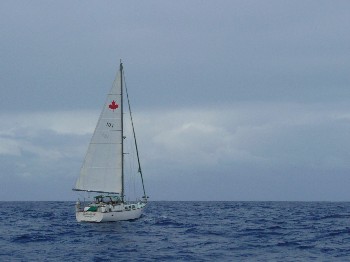
Don on
Sabbatical 2, hand-steering because his
autopilot broke down, nearing Hilo.
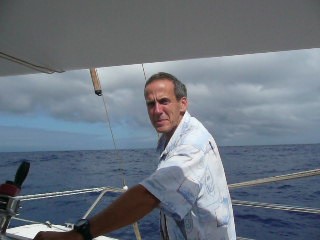
“Land Ho!” (He actually threw his arms
into the air and was grinning when he
yelled this, but we were both pretty
worn out and he couldn’t sustain the glee.)
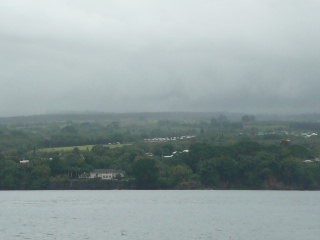
Our first sight of Hilo wasn’t too thrilling in itself,
but it sure was thrilling to see land again!
At 1:30 p.m. we turned left behind the breakwater and were
finally in the smooth waters of Hilo. Wow! How did we make it?
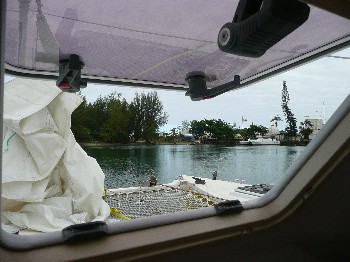
At last, we opened our front hatch (first time in
24 days) and let the cool breeze waft through a
damp and weary
Light Wave.
Carllie: It did not take long to anchor in tiny but protected
Radio Bay, and we quickly put together our PortaBote dinghy. While I waited
on the boat, Garett rowed to shore with our documentation to check in with Customs
and then let the Port Authority know we were on anchor in the bay. This took
awhile, as Customs was busy with a freighter, but Garett told me when we finally
did talk to the guy, he was so friendly and welcoming, and it was no problem
at all. Finally, after dark, Garett rowed back in the dinghy and we returned
to shore together for a long walk down the road into town. We really needed
to stretch our legs. As we passed Banyan Drive (where celebrities planted the
now huge banyan trees in the 1930’s), we heard a chorus of what I initially
thought were insomniac birds. Garett informed me that these noisy critters were
“coqui” tiny 2-inch frogs that were (as many creatures good and bad
have been) accidentally introduced to the Big Island from Puerto Rico, and as
there is no natural predator here they have proliferated. Apparently their croaky
song is as loud as a vacuum cleaner up close, and if one is under your window
you cannot sleep–so the hotels in Hilo all issue ear plugs. We hear a chorus
of coquis in Radio Bay after sunset for awhile each night, but luckily they
are not under our windows!
Saturday,
March 29, 2008
Carllie: Today, much to my surprise, I woke up with a splitting
headache, and was sick, sick, sick all day long. Later I figured out that it
was probably “drug withdrawal” as I had been using Transderm Scop
patches almost all the way across the Pacific, and tossed my final patch just
as we approached Hilo. There is undoubtedly a lot of poison in my system due
to these drugs that I am forced to use so that I am not seasick, and when I
get home I will have to do a couple of long liver cleanses with Dr. Schulze’s
products, which Garett and I do anyway at least twice a year. I would certainly
rather not take drugs of any shape or form, but I cannot let myself get seasick,
as once I succumb it’s very hard to get over and I have to be able to do my
watches.
While I was inert with an intense migraine all day long on
the boat, Garett walked a long way into the Farmer’s Market in town and bought
us our first delightful Big Island-grown fruits and vegetables: rainbow papaya
(delectable, 5 for $2), organic greens and tomatoes for salads, green onions,
apple bananas and such. He also walked from town (about 4-5 miles away) all
the way back towards our anchorage, veering off to walk another long distance
to the airport, where he rented a car. Then, when he got back I was still so
sick that he had to take all our laundry, accumulated over 26 days, and haul
it across the street to a laundromat. What a great guy! I am so sorry I could
not have been my usual helpful self, but if I sat up, I threw up. Things were
not good in my little world. And throwing up about 5 times when I had nothing
to throw up took so much out of me that it took about 5 days to get my energy
back to normal. Lucky for me, over the next 4 days we mostly drove around looking
at various sights around Hawai’i, though on one day at the Volcano National
Park, we walked about 9 miles and that was pretty exhausting! More on that later…
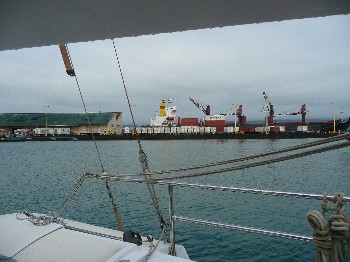
Even though the view from our anchorage in
Radio Bay toward the commercial dock
looks boring, it was
wonderful to be back
near land, and hearing the normal
land-based bustle.
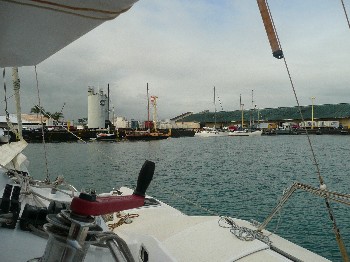
Almost every morning in Hilo started with a
dousing of rainfall. Usually it stopped within
about half an hour, and by mid-day the
clouds had dispersed. So
Light Wave got
good baths every day, yet was nice and
dry when we returned from our exploring.
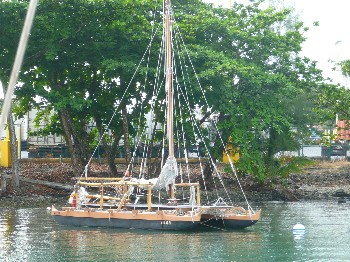
Traditional Hawai’ian “double hulled canoe”
anchored in Radio Bay, modeled after the
Hokule’a, a 62ft vessel built the traditional way
and lashed together that was launched in 1976
and sailed by Hawai’ians using only the ancient
Polynesian methods of navigating– with the stars,
the currents, watching the fish, dolphins, and birds–
to Tahiti and back in 1976, to Tahiti again in 1980,
to Aoteoroa (New Zealand), Tonga, Samoa, the Society
Islands and Cook Islands in 1985, Rarotonga in
1992, the Marquesas Islands in 1995, and Rapa
Nui (Easter Island) in 1999. The first voyage
ignited such pride among Hawai’ians that it and
all subseuqent voyages began a renaissance of
interest in their ancient culture and religion.
Today, especially here on the island of Hawai’i,
thousands of people practise the ancient chanting,
and the true art of the hula has been reclaimed.
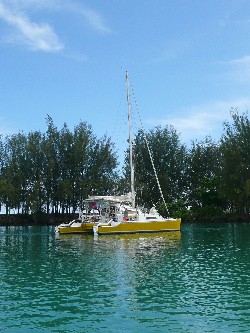
Modern multihull anchored
in Radio Bay…
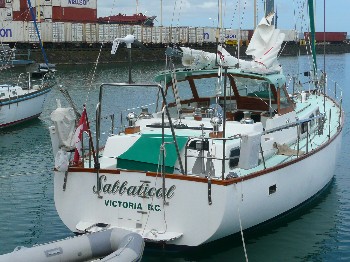
Here is Don’s Sabbatical II, up close.
It is a beautiful Maple Leaf 48 that he built
in eight years, and launched 30 years ago.
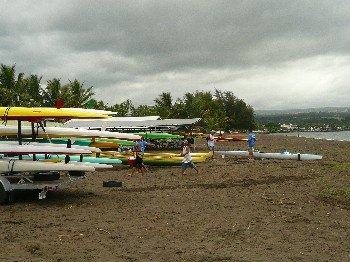
Hundreds of locals take their outrigger canoes
out to paddle in the big waves on their days off.
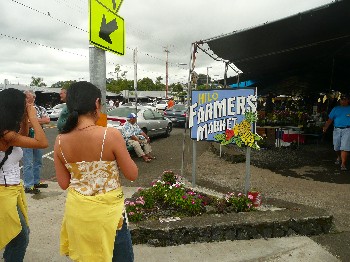
Farmer’s Market in downtown Hilo.
Sunday, March 30, 2008
We drove through Kapoa to Kapala lava fields.
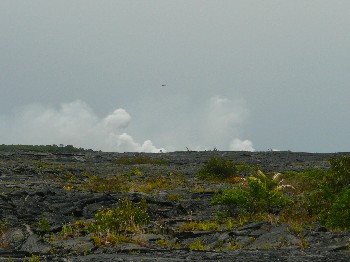
Some people buy young coconut trees to plant
in the lava fields.
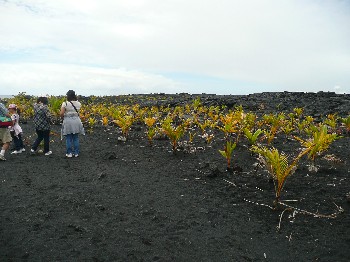
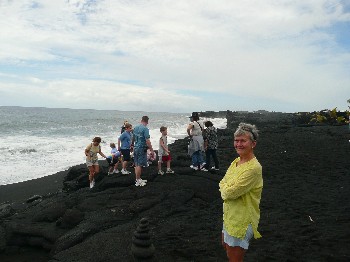
We had to walk along a marked path through the
lava field. Walking outside it could result
in breaking through the questionable crust (!)
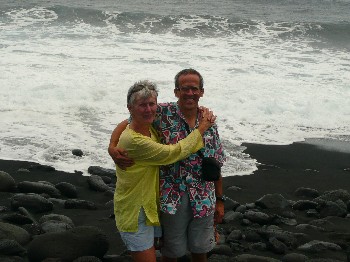 First picture of us together on land by the
famous Hawai’ian surf.
First picture of us together on land by the
famous Hawai’ian surf.

Waiting for the road to the crater to open,
we drove all around this area, checking out
hot pools on the water, a black sand beach,
and a lava tree forest.
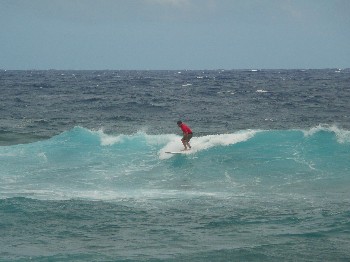
Watching surfers is always great fun.
How do they DO that??? Everyone here
learns to surf. Everyone. And Hawai’ians are so
natural with the water–little ones learning to
paddle outriggers are out there in the early mornings
(with no life vests), and while staying at Radio Bay
we often saw locals walking along the slippery big
rocks of the breakwater to fish, or even to sit on the
breakwater so the surf would break over them!
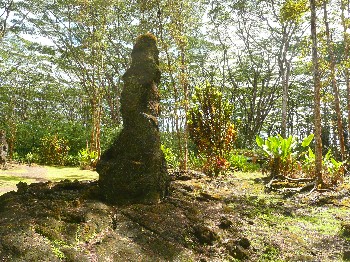
A “lava tree,” formed when the lava flowed through
this area, surrounded the trees, then left a
skeleton in lava.
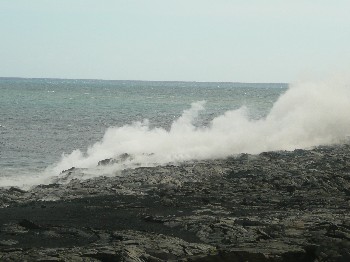
Steam flowing where the lava (Hawai’i’an god, Pele)
flows into the sea. This was a relatively small flow.
We saw huge billows of steam further down the coast,
but they had closed off access to this area as it is
dangerous to get too close.
Monday, March 31, 2008
Today, we visited Volcano National Park and walked a huge distance
(we later figured 9 miles) all around the park, which is built around active volcanoes.
We walked to and across Kilauea Caldera, still steaming, and I found that experience
eerie to say the least. At the top it is very cold and as they advise you in the
Lonely Planet’s Hawaii to bring a warm jacket and pants, we did, thankfully, as
it was icy up there. However, during our walk around and through the caldera,
we got pretty warm and carried or wore our jackets open.
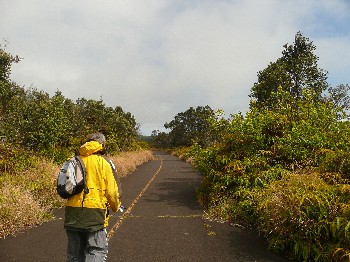
It was a long, long walk, and we were pretty
tired by the time we got back, but it was very
interesting. We have never been that close to
active volcanoes.
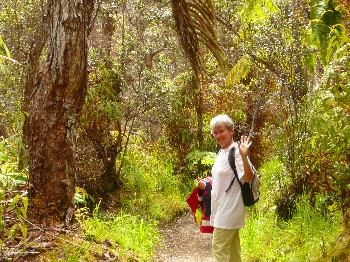
One of the trails through the recently formed woods (on
top of a previously volcano flow).
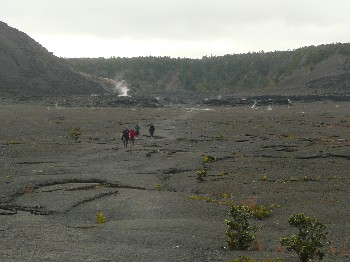
Walking across the Kilauea Caldera was eerie
to say the least, and I was quite anxious to get to
the other side. Garett spotted a steaming area at
one point, and put his hand out to it, only to be
burned. What a guy! Giving me the gears the
whole time because I was spooked.
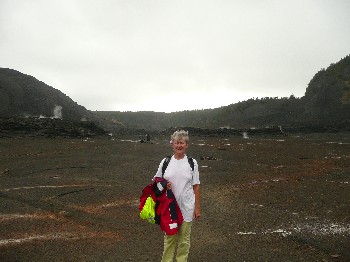
You can see I don’t look too comfortable.
You can also see why: steam vents all around us.
The wind was also blowing.

This is the huge billowing steam from the active
volcano flowing into the ocean, in the distance.
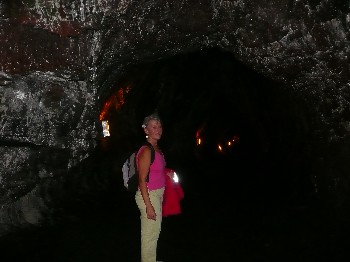
Just walking into Thurston Lava Tube. Short,
thankfully!
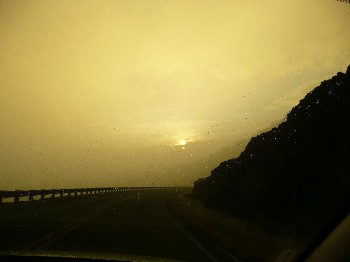
The “vog” (volcanic smog) obscures the air
as we drive up along the Chain of Craters Road.
Tags: offshore prep ocean crossing catamaran sailing cruising


















































































































 First picture of us together on land by the
famous Hawai’ian surf.
First picture of us together on land by the
famous Hawai’ian surf.









